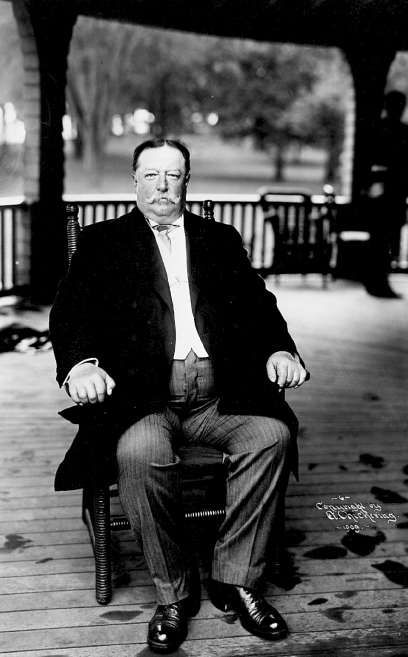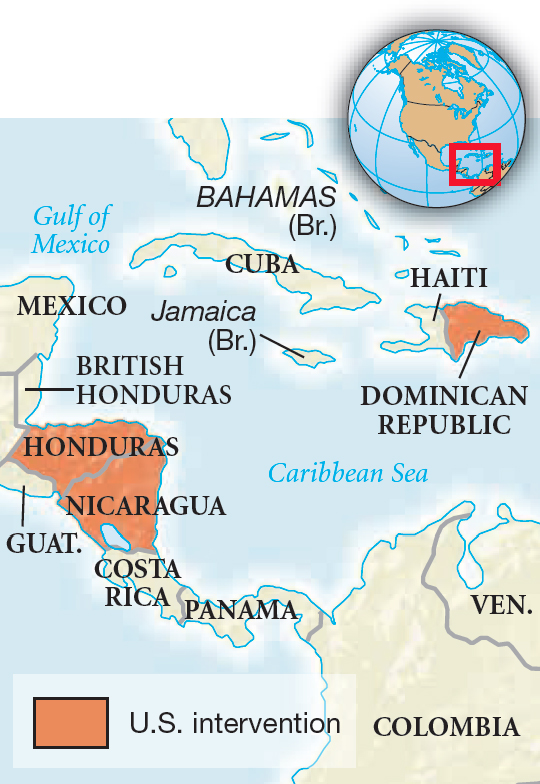The Troubled Presidency of William Howard Taft
Printed Page 628
Section Chronology
On the eve of his election in 1904, Roosevelt promised that he would not seek another term. So he retired from the presidency in 1909 at age fifty and removed himself from the political scene by going on safari in Africa. He turned the White House over to his handpicked successor, William Howard Taft, a lawyer who had served as governor-general of the Philippines. In the presidential election of 1908, Taft soundly defeated the perennial Democratic candidate, William Jennings Bryan.

A genial man with a talent for law, Taft had no experience in elective office, no feel for politics, and no nerve for controversy. His ambitious wife coveted the office and urged him to seek it. He would have been better off listening to his mother, who warned, “Roosevelt is a good fighter and enjoys it, but the malice of politics would make you miserable.”
Once in office, Taft proved a perfect tool in the hands of Republicans who yearned for a return to the days of a less active executive. A lawyer by training and instinct, Taft believed that it was up to the courts, not the president, to arbitrate social issues. Roosevelt had carried presidential power to a new level, often flouting the separation of powers and showing thinly veiled contempt for Congress and the courts. Taft found it difficult to condone Roosevelt’s actions. Wary of the progressive insurgents in Congress, Taft relied increasingly on conservatives in the Republican Party. As a progressive senator lamented, “Taft is a ponderous and amiable man completely surrounded by men who know exactly what they want.”
CHAPTER OVERVIEW
How did grassroots progressives attack the problems of industrial America?
What were the key tenets of progressive theory?
How did Theodore Roosevelt advance the progressive agenda?
How did progressivism evolve during Woodrow Wilson’s first term?
What were the limits of progressive reform?
Conclusion: How did the liberal state transform during the Progressive Era?
 LearningCurve
LearningCurve
Check what you know.
bedfordstmartins.com/roarkunderstanding
Taft’s troubles began on the eve of his inaugural, when he called a special session of Congress to deal with the tariff. Roosevelt had been too politically astute to tackle the troublesome tariff issue, even though he knew that rates needed to be lowered. Taft blundered into the fray. The Payne-Aldrich bill that emerged was amended in the Senate so that it actually raised the tariff, benefiting big business and the trusts at the expense of consumers. As if paralyzed, Taft neither fought for changes nor vetoed the measure. On a tour of the Midwest in 1909, he was greeted with jeers when he claimed, “I think the Payne bill is the best bill that the Republican Party ever passed.” In the eyes of a growing number of Americans, Taft’s praise of the tariff made him either a fool or a liar.
Taft’s legalism soon got him into hot water in the area of conservation. He undid Roosevelt’s work to preserve hydroelectric power sites when he learned that they had been improperly designated as ranger stations. And when Gifford Pinchot publicly denounced Taft’s secretary of the interior as a tool of western land-grabbers, Taft fired Pinchot, touching off a storm of controversy that damaged Taft and alienated Roosevelt.

When Roosevelt returned to the United States in June 1910, he received a hero’s welcome and attracted a stream of visitors and reporters seeking his advice and opinions. Hurt, Taft kept his distance. By late summer, Roosevelt had taken sides with the progressive insurgents in his party. “Taft is utterly hopeless as a leader,” Roosevelt confided to his son as he set out on a speaking tour of the West. Reading the mood of the country, Roosevelt began to sound more and more like a candidate.
With the Republican Party divided, the Democrats swept the congressional elections of 1910. Branding the Payne-Aldrich tariff “the mother of trusts,” they captured a majority in the House of Representatives and won several key governorships. The revitalized Democratic Party could look to new leaders, among them the progressive governor of New Jersey, Woodrow Wilson.
The new Democratic majority in the House, working with progressive Republicans in the Senate, achieved a number of key reforms, including legislation to regulate mine and railroad safety, to create the Children’s Bureau in the Department of Labor, and to establish an eight-hour day for federal workers. Two significant constitutional amendments — the Sixteenth Amendment, which provided for a modest graduated income tax, and the Seventeenth Amendment, which called for the direct election of senators (formerly chosen by state legislatures) — went to the states, where they would win ratification in 1913. While Congress rode the high tide of progressive reform, Taft sat on the sidelines.
In foreign policy, Taft continued Roosevelt’s policy of extending U.S. influence abroad, but here, too, Taft had a difficult time following Roosevelt. Taft’s “dollar diplomacy” championed commercial goals rather than the strategic aims Roosevelt had pursued. Taft naively assumed he could substitute “dollars for bullets.” In the Caribbean, he provoked anti-American feeling by dispatching U.S. Marines to Nicaragua and the Dominican Republic in 1912 pursuant to the Roosevelt Corollary. In Asia, he openly avowed his intent to promote “active intervention to secure for … our capitalists opportunity for profitable investment.” Lacking Roosevelt’s understanding of power politics, Taft failed to recognize that an aggressive commercial policy could not exist without the willingness to use military might to back it up.
Taft faced the limits of dollar diplomacy when revolution broke out in Mexico in 1911. Under pressure to protect American investments, he mobilized troops along the border. In the end, however, with no popular support for a war with Mexico, he had to fall back on diplomatic pressure to salvage American interests.
Taft’s greatest dream was to encourage world peace through the use of a world court and arbitration. He unsuccessfully sponsored a series of arbitration treaties that Roosevelt, who prized national honor more than international law, vehemently opposed as weak and cowardly. By 1910, Roosevelt had become a vocal critic of Taft’s foreign policy.
The final breach between Taft and Roosevelt came in 1911, when Taft’s attorney general filed an antitrust suit against U.S. Steel. In its brief against the corporation, the government cited Roosevelt’s agreement with the Morgan interests in the 1907 acquisition of Tennessee Coal and Iron. The incident greatly embarrassed Roosevelt. Thoroughly enraged, he lambasted Taft’s “archaic” antitrust policy and hinted that he might be persuaded to run for president again.
QUICK REVIEW
Question
WfciThoB8LmP/WkQfza9pVNRmXOXDRSH3ZOpL70+2ZpRAW8To46H9BAKEJu5ZsShjlCvo3kKm+v5tAPR0FrbPvCdFgtIWG4Wkxd9/r1HWo9nLFWmWUtiC/F7NKoirzL4Gi3GuFj2LxIjtZ+9ilc9mXDomFexffNp/AfcCswINW6f/N05k4ekuQk70Y19H5Ecoz5X1FcWdyJYd+/5/GvL/5UL6e2MRe7P/JS4vg==CHAPTER OVERVIEW
How did grassroots progressives attack the problems of industrial America?
What were the key tenets of progressive theory?
How did Theodore Roosevelt advance the progressive agenda?
How did progressivism evolve during Woodrow Wilson’s first term?
What were the limits of progressive reform?
Conclusion: How did the liberal state transform during the Progressive Era?
 LearningCurve
LearningCurve
Check what you know.
bedfordstmartins.com/roarkunderstanding